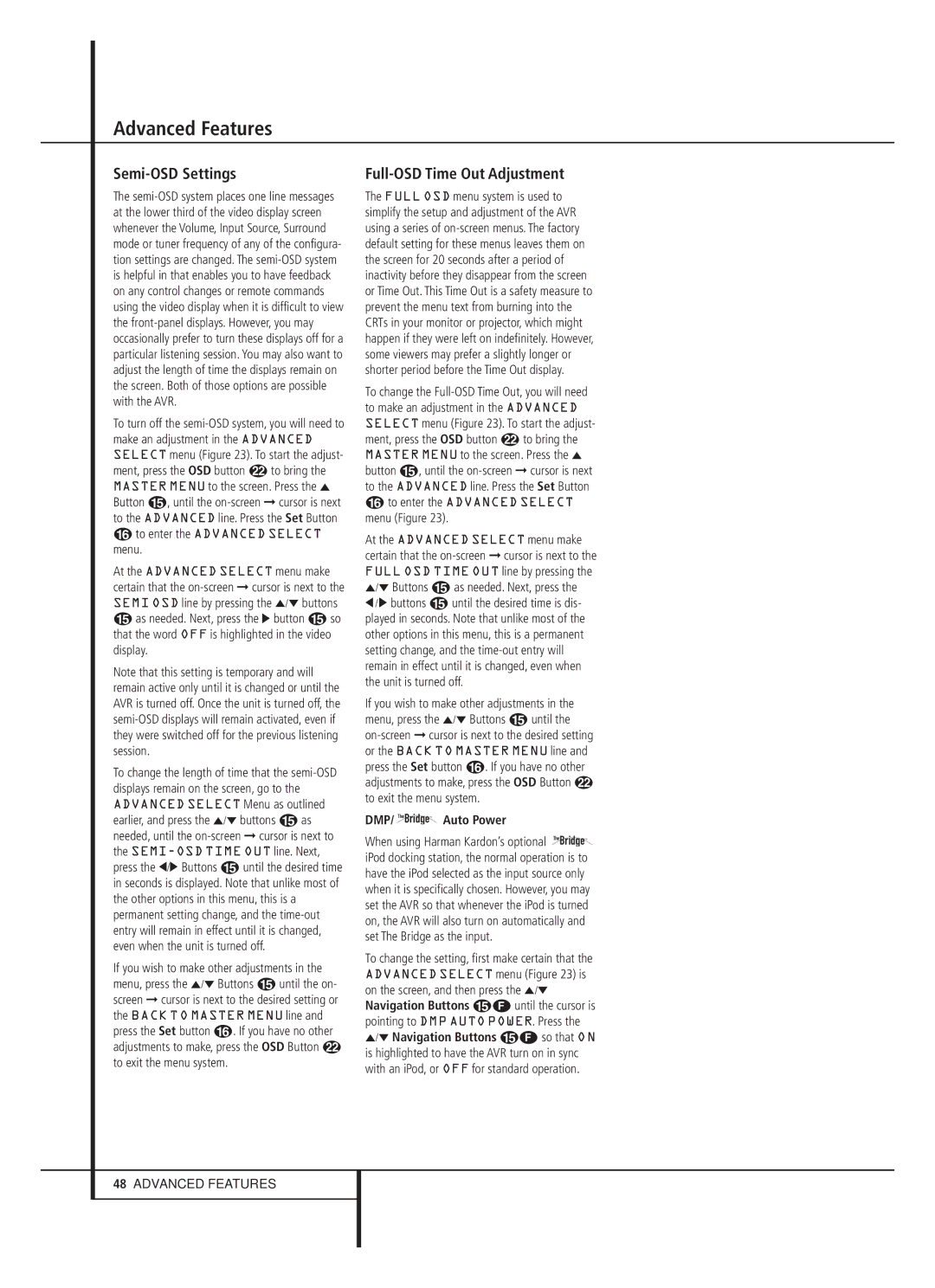Advanced Features
Semi-OSD Settings
The semi-OSD system places one line messages at the lower third of the video display screen whenever the Volume, Input Source, Surround mode or tuner frequency of any of the configura- tion settings are changed. The semi-OSD system is helpful in that enables you to have feedback on any control changes or remote commands using the video display when it is difficult to view the front-panel displays. However, you may occasionally prefer to turn these displays off for a particular listening session. You may also want to adjust the length of time the displays remain on the screen. Both of those options are possible with the AVR.
To turn off the semi-OSD system, you will need to make an adjustment in the ADVANCED SELECT menu (Figure 23). To start the adjust- ment, press the OSD button L to bring the MASTER MENU to the screen. Press the ⁄ Button E, until the on-screen ➞ cursor is next to the ADVANCED line. Press the Set Button
Fto enter the ADVANCED SELECT menu.
At the ADVANCED SELECT menu make certain that the on-screen ➞ cursor is next to the SEMI OSD line by pressing the ⁄/¤ buttons
Eas needed. Next, press the › button E so that the word OFF is highlighted in the video display.
Note that this setting is temporary and will remain active only until it is changed or until the AVR is turned off. Once the unit is turned off, the semi-OSD displays will remain activated, even if they were switched off for the previous listening session.
To change the length of time that the semi-OSD displays remain on the screen, go to the ADVANCED SELECT Menu as outlined earlier, and press the ⁄/¤ buttons E as needed, until the on-screen ➞ cursor is next to the SEMI-OSD TIME OUT line. Next, press the ‹/› Buttons E until the desired time in seconds is displayed. Note that unlike most of the other options in this menu, this is a permanent setting change, and the time-out entry will remain in effect until it is changed, even when the unit is turned off.
If you wish to make other adjustments in the menu, press the ⁄/¤ Buttons E until the on- screen ➞ cursor is next to the desired setting or the BACK TO MASTER MENU line and press the Set button F. If you have no other adjustments to make, press the OSD Button L to exit the menu system.
Full-OSD Time Out Adjustment
The FULL OSD menu system is used to simplify the setup and adjustment of the AVR using a series of on-screen menus. The factory default setting for these menus leaves them on the screen for 20 seconds after a period of inactivity before they disappear from the screen or Time Out. This Time Out is a safety measure to prevent the menu text from burning into the CRTs in your monitor or projector, which might happen if they were left on indefinitely. However, some viewers may prefer a slightly longer or shorter period before the Time Out display.
To change the Full-OSD Time Out, you will need to make an adjustment in the ADVANCED SELECT menu (Figure 23). To start the adjust- ment, press the OSD button L to bring the MASTER MENU to the screen. Press the ⁄ button E, until the on-screen ➞ cursor is next to the ADVANCED line. Press the Set Button
Fto enter the ADVANCED SELECT menu (Figure 23).
At the ADVANCED SELECT menu make certain that the on-screen ➞ cursor is next to the FULL OSD TIME OUT line by pressing the ⁄/¤ Buttons E as needed. Next, press the
‹/ › buttons E until the desired time is dis- played in seconds. Note that unlike most of the other options in this menu, this is a permanent setting change, and the time-out entry will remain in effect until it is changed, even when the unit is turned off.
If you wish to make other adjustments in the menu, press the ⁄/¤ Buttons E until the on-screen ➞ cursor is next to the desired setting or the BACK TO MASTER MENU line and press the Set button F. If you have no other adjustments to make, press the OSD Button L to exit the menu system.
DMP/ TheBridgeTMAuto Power
When using Harman Kardon’s optional  iPod docking station, the normal operation is to have the iPod selected as the input source only when it is specifically chosen. However, you may set the AVR so that whenever the iPod is turned on, the AVR will also turn on automatically and set The Bridge as the input.
iPod docking station, the normal operation is to have the iPod selected as the input source only when it is specifically chosen. However, you may set the AVR so that whenever the iPod is turned on, the AVR will also turn on automatically and set The Bridge as the input.
To change the setting, first make certain that the ADVANCED SELECT menu (Figure 23) is on the screen, and then press the ⁄/¤ Navigation Buttons EF until the cursor is pointing to DMP AUTO POWER. Press the ⁄/¤ Navigation Buttons EF so that ON is highlighted to have the AVR turn on in sync with an iPod, or OFF for standard operation.

